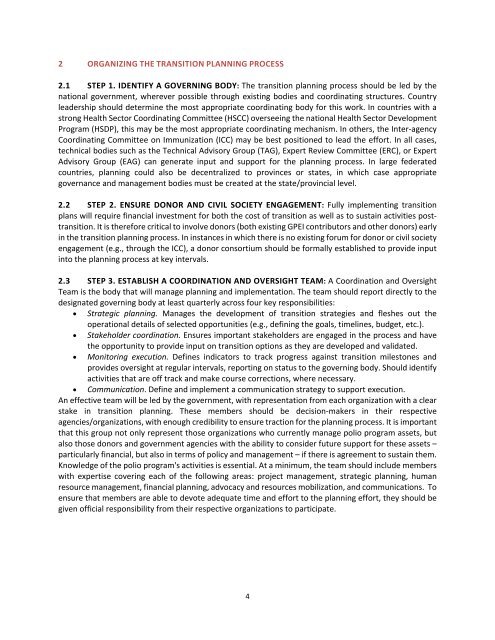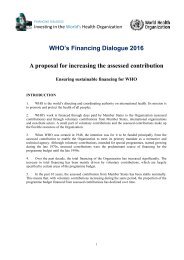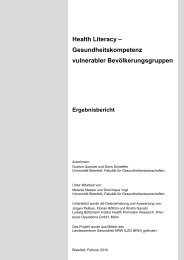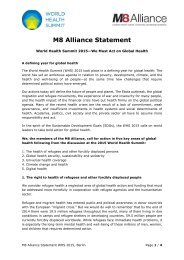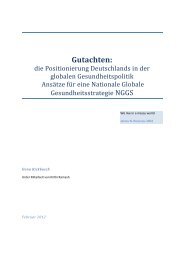POLIO PLANNING
TransitionGuidelinesForPolioLegacy
TransitionGuidelinesForPolioLegacy
You also want an ePaper? Increase the reach of your titles
YUMPU automatically turns print PDFs into web optimized ePapers that Google loves.
2 ORGANIZING THE TRANSITION <strong>PLANNING</strong> PROCESS<br />
2.1 STEP 1. IDENTIFY A GOVERNING BODY: The transition planning process should be led by the<br />
national government, wherever possible through existing bodies and coordinating structures. Country<br />
leadership should determine the most appropriate coordinating body for this work. In countries with a<br />
strong Health Sector Coordinating Committee (HSCC) overseeing the national Health Sector Development<br />
Program (HSDP), this may be the most appropriate coordinating mechanism. In others, the Inter-agency<br />
Coordinating Committee on Immunization (ICC) may be best positioned to lead the effort. In all cases,<br />
technical bodies such as the Technical Advisory Group (TAG), Expert Review Committee (ERC), or Expert<br />
Advisory Group (EAG) can generate input and support for the planning process. In large federated<br />
countries, planning could also be decentralized to provinces or states, in which case appropriate<br />
governance and management bodies must be created at the state/provincial level.<br />
2.2 STEP 2. ENSURE DONOR AND CIVIL SOCIETY ENGAGEMENT: Fully implementing transition<br />
plans will require financial investment for both the cost of transition as well as to sustain activities posttransition.<br />
It is therefore critical to involve donors (both existing GPEI contributors and other donors) early<br />
in the transition planning process. In instances in which there is no existing forum for donor or civil society<br />
engagement (e.g., through the ICC), a donor consortium should be formally established to provide input<br />
into the planning process at key intervals.<br />
2.3 STEP 3. ESTABLISH A COORDINATION AND OVERSIGHT TEAM: A Coordination and Oversight<br />
Team is the body that will manage planning and implementation. The team should report directly to the<br />
designated governing body at least quarterly across four key responsibilities:<br />
• Strategic planning. Manages the development of transition strategies and fleshes out the<br />
operational details of selected opportunities (e.g., defining the goals, timelines, budget, etc.).<br />
• Stakeholder coordination. Ensures important stakeholders are engaged in the process and have<br />
the opportunity to provide input on transition options as they are developed and validated.<br />
• Monitoring execution. Defines indicators to track progress against transition milestones and<br />
provides oversight at regular intervals, reporting on status to the governing body. Should identify<br />
activities that are off track and make course corrections, where necessary.<br />
• Communication. Define and implement a communication strategy to support execution.<br />
An effective team will be led by the government, with representation from each organization with a clear<br />
stake in transition planning. These members should be decision-makers in their respective<br />
agencies/organizations, with enough credibility to ensure traction for the planning process. It is important<br />
that this group not only represent those organizations who currently manage polio program assets, but<br />
also those donors and government agencies with the ability to consider future support for these assets –<br />
particularly financial, but also in terms of policy and management – if there is agreement to sustain them.<br />
Knowledge of the polio program's activities is essential. At a minimum, the team should include members<br />
with expertise covering each of the following areas: project management, strategic planning, human<br />
resource management, financial planning, advocacy and resources mobilization, and communications. To<br />
ensure that members are able to devote adequate time and effort to the planning effort, they should be<br />
given official responsibility from their respective organizations to participate.<br />
4


